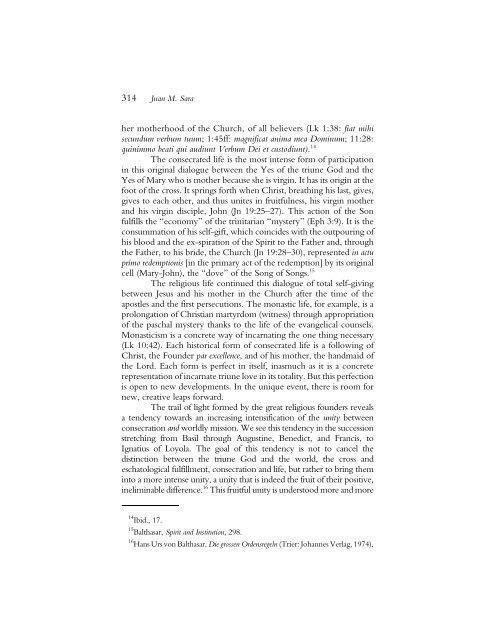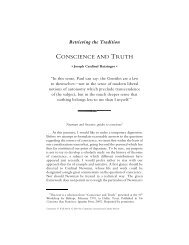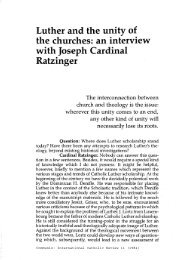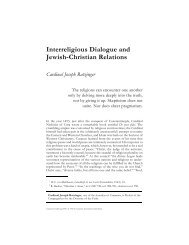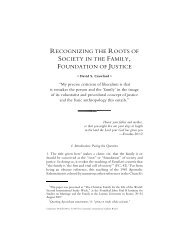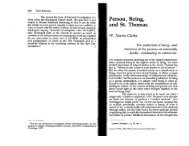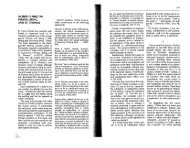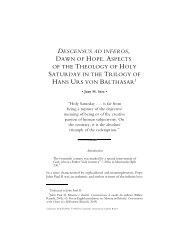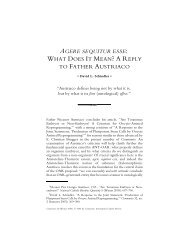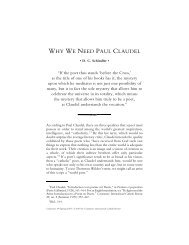Juan Sara. Secular Institutes According to Hans Urs ... - Communio
Juan Sara. Secular Institutes According to Hans Urs ... - Communio
Juan Sara. Secular Institutes According to Hans Urs ... - Communio
Create successful ePaper yourself
Turn your PDF publications into a flip-book with our unique Google optimized e-Paper software.
314 <strong>Juan</strong> M. <strong>Sara</strong><br />
her motherhood of the Church, of all believers (Lk 1:38: fiat mihi<br />
secundum verbum tuum; 1:45ff: magnificat anima mea Dominum; 11:28:<br />
quinimmo beati qui audiunt Verbum Dei et cus<strong>to</strong>diunt). 14<br />
The consecrated life is the most intense form of participation<br />
in this original dialogue between the Yes of the triune God and the<br />
Yes of Mary who is mother because she is virgin. It has its origin at the<br />
foot of the cross. It springs forth when Christ, breathing his last, gives,<br />
gives <strong>to</strong> each other, and thus unites in fruitfulness, his virgin mother<br />
and his virgin disciple, John (Jn 19:25–27). This action of the Son<br />
fulfills the “economy” of the trinitarian “mystery” (Eph 3:9). It is the<br />
consummation of his self-gift, which coincides with the outpouring of<br />
his blood and the ex-spiration of the Spirit <strong>to</strong> the Father and, through<br />
the Father, <strong>to</strong> his bride, the Church (Jn 19:28–30), represented in actu<br />
primo redemptionis [in the primary act of the redemption] by its original<br />
cell (Mary-John), the “dove” of the Song of Songs. 15<br />
The religious life continued this dialogue of <strong>to</strong>tal self-giving<br />
between Jesus and his mother in the Church after the time of the<br />
apostles and the first persecutions. The monastic life, for example, is a<br />
prolongation of Christian martyrdom (witness) through appropriation<br />
of the paschal mystery thanks <strong>to</strong> the life of the evangelical counsels.<br />
Monasticism is a concrete way of incarnating the one thing necessary<br />
(Lk 10:42). Each his<strong>to</strong>rical form of consecrated life is a following of<br />
Christ, the Founder par excellence, and of his mother, the handmaid of<br />
the Lord. Each form is perfect in itself, inasmuch as it is a concrete<br />
representation of incarnate triune love in its <strong>to</strong>tality. But this perfection<br />
is open <strong>to</strong> new developments. In the unique event, there is room for<br />
new, creative leaps forward.<br />
The trail of light formed by the great religious founders reveals<br />
a tendency <strong>to</strong>wards an increasing intensification of the unity between<br />
consecration and worldly mission. We see this tendency in the succession<br />
stretching from Basil through Augustine, Benedict, and Francis, <strong>to</strong><br />
Ignatius of Loyola. The goal of this tendency is not <strong>to</strong> cancel the<br />
distinction between the triune God and the world, the cross and<br />
escha<strong>to</strong>logical fulfillment, consecration and life, but rather <strong>to</strong> bring them<br />
in<strong>to</strong> a more intense unity, a unity that is indeed the fruit of their positive,<br />
ineliminable difference. 16 This fruitful unity is unders<strong>to</strong>od more and more<br />
14 Ibid., 17.<br />
15 Balthasar, Spirit and Institution, 298.<br />
16 <strong>Hans</strong> <strong>Urs</strong> von Balthasar, Die grossen Ordensregeln (Trier: Johannes Verlag, 1974),


